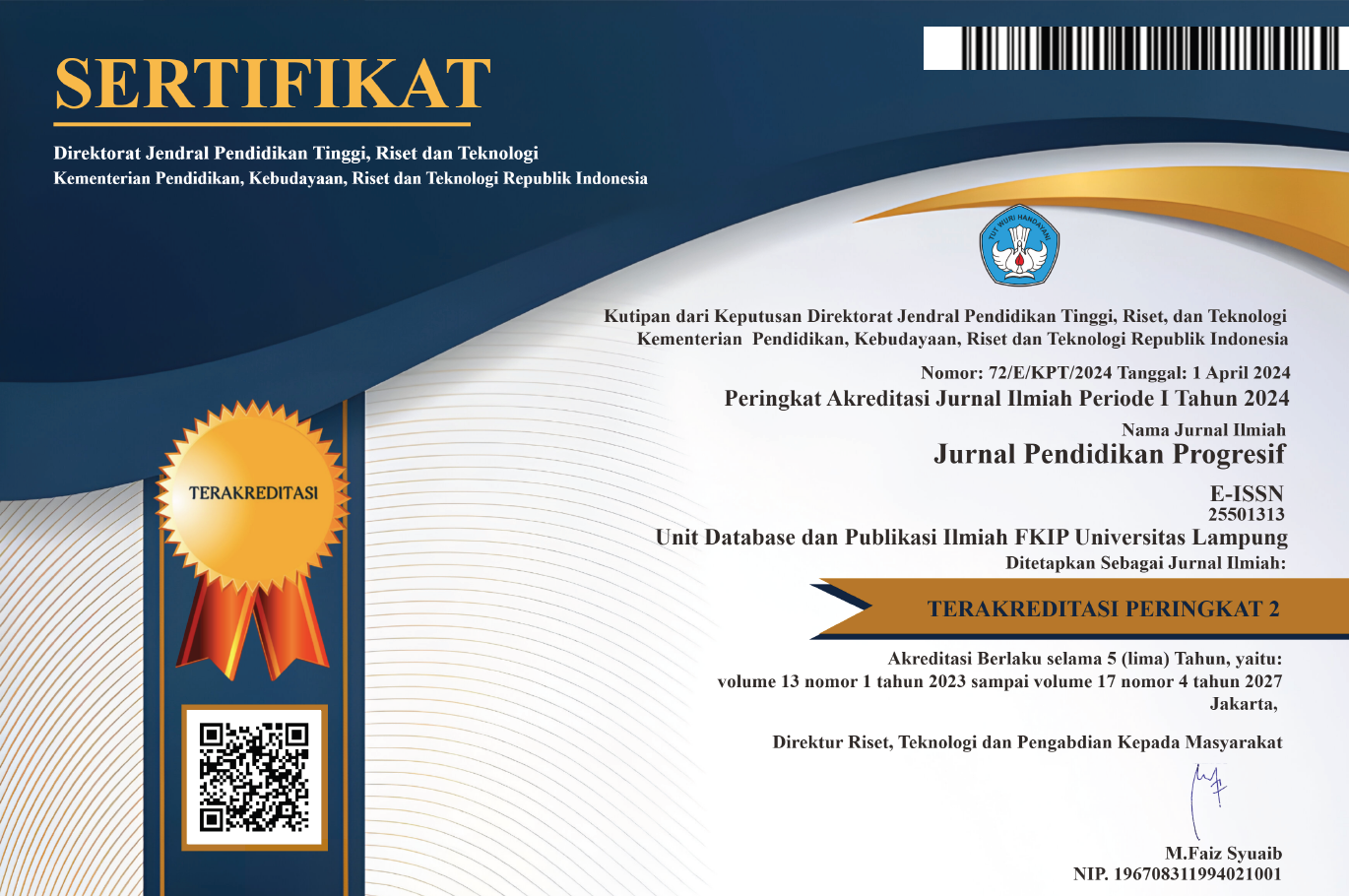The Effect of Team Assisted Individualization Instructional Strategies to Enhance Problem Solving Ability, Learning Activity and Mathematics Learning Achievement
 Country:
Country:
(1) Universitas Pancasakti Tegal, Indonesia
(2) Universitas Pancasakti Tegal, Indonesia
(3) Universitas Pancasakti Tegal, Indonesia
| Metrics→ |
| Indexing Site→ |
Copyright (c) 2019 Afifah Nur Qomariyah, Isnaini Isnaini, Wikan Budi Utami
The effect of team assisted individualization instructional strategies to enhance problem solving ability, learning activity, and mathematics learning achievement. Objectives: The purpose of this study is to determine the effectiveness of TAI learning medol on students’ ability to solve problems. Methods: The research method uses a quantitative approach with experimental research design. The research subjects involved 83 students of grade VIII at SMP Negeri 10 Tegal. Findings: The results of the proportion test on students using the TAI instructional strategies show that zcount > ztable (1.833 > 1.64), while the MANOVA test results show λcount < λtable (0.122 < 0.903), and the test results of τ2-Hotelling obtained Fcount > Ftable (8.63 > 2.76). Conclusions: The TAI instructional strategies is effective in improving problem solving skills, learning effectiveness, and mathematics learning achievement of students.
Keywords: Team assisted individualization, problem solving ability, learning activity, mathematics learning achievement
Arif, A. (2015). Efektivitas Model Pembelajaran Team Assisted Individualization (TAI) Terhadap Aktivitas Belajar dan Hasil Belajar Ekonomi Siswa Kelas X SMA Teuku Umar Semarang Tahun 2014/2015. Economic Education Analysis Journal, 4(3), 735–749.
Artut, P. D. (2016). Effect of Cooperative Learning Method on Prospective Teachers’ Non-routine Problem-Solving Skills and Their Views About the Method. US-China Education Review, 6(4), 244–254.
Astuti, D., Khasanah, U., & Romadon, S. (2018, January). The Effect of Thinking Empowerment by Questioning (TEQ) through Team-Assisted Individualization (TAI) Learning Model to Metacognitive and Learning Achievement. In Ahmad Dahlan International Conference on Mathematics and Mathematics Education (Vol. 1, pp. 182–186).
Bellot, J., Sigaud, O., & Khamassi, M. (2012). Which Temporal Difference Learning Algorithm Best Reproduces Dopamine Activity in a Multi-choice Task? In International Conference on Simulation of Adaptive Behavior (pp. 289–298). Springer, Berlin, Heidelberg.
Eliyah, S., Isnani, I., & Utami, W. B. (2018). Keefektifan Model Pembelajaran Course Review Horay Berbantuan PowerPoint Terhadap Kepercayaan Diri dan Prestasi Belajar. JES-MAT (Jurnal Edukasi dan Sains Matematika), 4(2), 131–140.
Fadlelmula, F. K., Cakiroglu, E., & Sungur, S. (2015). Developing a Structural Model on the Relationship Among Motivational Beliefs, Self-regulated Learning Strategies, and Achievement in Mathematics. International Journal of Science and Mathematics Education, 13(6), 1355–1375.
Farnika, N., Ikhsan, M., & Sofyan, H. (2015). Peningkatan Kemampuan Pemahaman dan Pemecahan Masalah Matematis Siswa Sekolah Menengah Atas dengan Model Pembelajaran Kooperatif Tipe Team Assisted Individualization. Jurnal Elemen, 1(2), 144–152.
Firdaus, D. A., & Afriansyah, E. A. (2016). Pembelajaran Kooperatif Tipe Team Assisted Individually untuk Meningkatkan Kemampuan Pemahaman Matematis Siswa Sekolah Menengah Pertama. Jurnal Pendidikan Matematika RAFA, 2(1), 104–122.
Hamdani. (2011). Strategi Belajar Mengajar. Bandung: Pustaka Setia.
Hecimovich, M., & Volet, S. (2014). Simulated Learning in Musculoskeletal Assessment and Rehabilitation Education: Comparing the Effect of a Simulation-Based Learning Activity with a Peer-Based Learning Activity. BMC Medical Education, 14(1), 253.
Isnani, M. S., & Ambarwati, R. (2011). Keefektifan Metode Think, Pair and Share Dalam Pembelajaran Matematika Berbantuan CD Interaktif Materi Bangun Ruang Kelas V. Cakrawala: Jurnal Pendidikan, 6(2).
Kim, K., & Moon, N. (2018). Activity Index Model for Self-Regulated Learning with Learning Analysis in a TEL Environment. The Journal of Supercomputing, 1–19.
Lestari, K. E., & Ridwan, M. (2017). Penelitian Pendidikan Matematika. Bandung: Refika Aditama.
Lonsdale, C., Sanders, T., Cohen, K. E., Parker, P., Noetel, M., Hartwig, T., ... & Moodie, M. (2016). Scaling-up an Efficacious School-Based Physical Activity Intervention: Study Protocol for the ‘Internet-Based Professional Learning to Help Teachers Support Activity in Youth’ (iPLAY) Cluster Randomized Controlled Trial and Scale-Up Implementation Evaluation. BMC Public Health, 16(1), 873.
Marouani, H., Zografidis, A., & Iliadis, A. (2011). Kinetic Nomograms Assist Individualization of Drug Regimens. Clinical Pharmacokinetics, 50(12), 773–779.
Mulyono, A., Isnani, & Susongko, P. (2018). Pengaruh Minat Belajar dan Kemampuan Visual terhadap Kemampuan Pemecahan Masalah dalam Pembelajaran Matematika dengan Pendekatan Realistic Mathematic Education pada Materi Bangun Ruang Sisi Datar. JPMP, 2(1).
Ngware, M. W., Ciera, J., Musyoka, P. K., & Oketch, M. (2015). Quality of Teaching Mathematics and Learning Achievement Gains: Evidence from Primary Schools in Kenya. Educational Studies in Mathematics, 89(1), 111–131.
Nneji, L. (2011). Impact of Framing and Team Assisted Individualized Instructional Strategies Students’ Achievement in Basic Science in the North Central Zone of Nigeria. Knowledge Review, 23(4), 1–8.
Shoimin, A. (2014). 68 Model Pembelajaran Inovatif dalam Kurikulum 2013. Yogyakarta: Ar-Ruzz Media.
Sholikhah, Z., Kartana, T. J., & Utami, W. B. (2018). Efektifitas Model Pembelajaran Open-Ended Terhadap Prestasi Belajar Matematika Ditinjau dari Kreativitas Siswa. JES-MAT (Jurnal Edukasi dan Sains Matematika), 4(1), 35–46.
Smith, T. J., McKenna, C. M., & Hines, E. (2014). Association of Group Learning with Mathematics Achievement and Mathematics Attitude Among Eighth-Grade Students in the US. Learning Environments Research, 17(2), 229–241.
Subekti, I., Kartana, T. J., & Utami, W. B. (2017). Keefektifan Model Pembelajaran Talking Stick Terhadap Sikap dan Prestasi Belajar Matematika pada Materi Aritmatika Sosial. Jurnal Dialektika Program Studi Pendidikan Matematika, 4(2), 43–49.
Susongko, P. (2016). Pengantar Metodologi Penelitian Pendidikan. Tegal: Universitas Pancasakti.
Tinungki, G. M. (2015). The Role of Cooperative Learning Type Team Assisted Individualization to Improve the Students’ Mathematics Communication Ability in the Subject of Probability Theory. Journal of Education and Practice, 6(32), 27–31.
Tu’u, T. S. (2007). Peran Disiplin pada Perilaku dan Prestasi Siswa. Jakarta: PT Grasindo.
Yang, X. (2015). Rural Junior Secondary School Students’ Perceptions of Classroom Learning Environments and Their Attitude and Achievement in Mathematics in West China. Learning Environments Research, 18(2), 249–266.
Yeh, C. Y., Cheng, H. N., Chen, Z. H., Liao, C. C., & Chan, T. W. (2019). Enhancing Achievement and Interest in Mathematics Learning Through Math-Island. Research and Practice in Technology Enhanced Learning, 14(1), 5.
Refbacks
- There are currently no refbacks.

This work is licensed under a Creative Commons Attribution-ShareAlike 4.0 International License.
View My Stats


